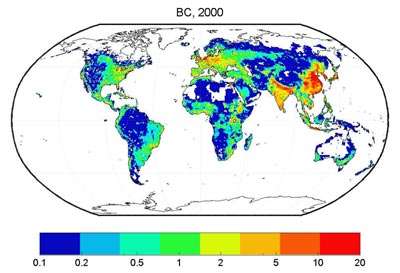January 28, 2014 report
Study shows airborne black carbon soot much worse than thought in China and India

(Phys.org) —A team made up of researchers from France and China has developed a new model for describing the amount of black carbon soot pollution in the air. In their paper published in Proceedings of the National Academy of Sciences, the team describes how they used new data to allow for better describing more localized soot pollution levels and found that some parts of India and China have far more soot in the air (up to two or three times more in some areas) than other models have suggested.
Airborne black carbon soot is in essence, the charred remains of fossil fuels that didn't fully burn due to insufficient oxygen—it's little black particles floating in the air. In addition to being unsightly, it also poses a health hazard for those who breathe it in. Up till now, most reports on soot levels have been nationally based—levels of soot have been measured in the air in various parts of a country and then averaged together to give a single number for a particular country. The problem with this approach, of course, is that it fails to account for regional differences. Those living downwind from a coal plant, for example, are likely to have far higher levels of soot in their air than those living near a solar collection farm. Another less well known problem with soot models or reports regarding their levels, is the lack of accounting for the differing amounts of soot that result from different types of polluters, i.e. some coal plants produce much more soot then others. Also some soot results from other sources such as burning crops (rice fields, etc.) or from burning biofuels. All produce different amounts of soot.
In this new effort, the researchers applied new fuel consumption data from various sources along with other new data that better describes how much soot different processes produce. The result is a model defined by regions, rather than countries, which the researchers claim has a bias reduction of −88 percent to −35 percent in Asia and indicates a whopping 130 percent higher worldwide concentration rate than that obtained from traditional country defined models.
Because the team came up with such striking results, it's likely other teams will join the effort to better estimate the true amount of soot people are breathing, which hopefully will lead to stronger efforts to reduce it.
More information: Exposure to ambient black carbon derived from a unique inventory and high-resolution model, Rong Wang, PNAS, DOI: 10.1073/pnas.1318763111
Abstract
Black carbon (BC) is increasingly recognized as a significant air pollutant with harmful effects on human health, either in its own right or as a carrier of other chemicals. The adverse impact is of particular concern in those developing regions with high emissions and a growing population density. The results of recent studies indicate that BC emissions could be underestimated by a factor of 2–3 and this is particularly true for the hot-spot Asian region. Here we present a unique inventory at 10-km resolution based on a recently published global fuel consumption data product and updated emission factor measurements. The unique inventory is coupled to an Asia-nested (∼50 km) atmospheric model and used to calculate the global population exposure to BC with fully quantified uncertainty. Evaluating the modeled surface BC concentrations against observations reveals great improvement. The bias is reduced from −88% to −35% in Asia when the unique inventory and higher-resolution model replace a previous inventory combined with a coarse-resolution model. The bias can be further reduced to −12% by downscaling to 10 km using emission as a proxy. Our estimated global population-weighted BC exposure concentration constrained by observations is 2.14 μg⋅m−3; 130% higher than that obtained using less detailed inventories and low-resolution models.
Journal information: Proceedings of the National Academy of Sciences
© 2014 Phys.org
















